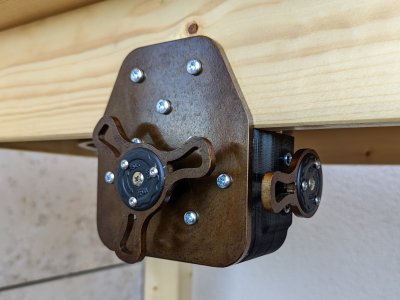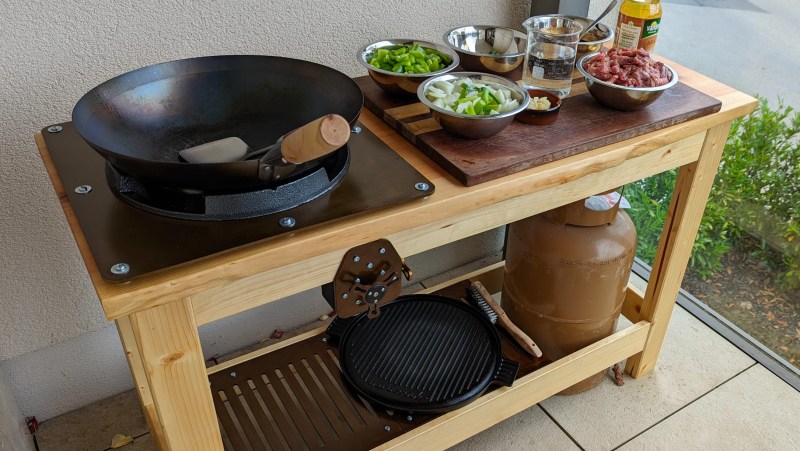[shoobs] relocated from Australia to Luxembourg, and was really missing the whole outdoor cooking scene that is apparently very common in those parts. Now living in a modest apartment building in the city, he had no easy way to recreate some of his favorite cooking methods — specifically that of Wok Hei (breath of a wok) — the art of Cantonese stir-frying which uses searing heat and a lot of flinging around of the food to mix it up with the burning oil. This results in a complex set of reactions utilizing smoking, caramelization, and Maillard reactions to produce the classic Cantonese smoky flavor. Not wanting an off-the-shelf solution [shoobs] took it on himself to build a balcony cooking station capable of the temperatures needed for Wok Hei, and documented it for our viewing pleasure.

The build started with sourcing a free-standing burner unit from Alibaba, which proved to be a little less powerful (at 30 kW) than ideal, but still sufficient. After locating a matching regulator and pressure gauge capable of the needed flow rate to feed the hungry burner, the next task was to construct a sturdy enough bench to mount it all. This was constructed from Douglas fir slabs, butt-jointed using a 3D printed drilling jig for ease of construction.
Using a flatbed scanner, the existing burner base was digitized in order to make a model suitable for laser-cutting a new mounting plate from steel. [Shoobs] isn’t lucky enough to have access to a metal-capable laser cutter — he sent his cad files off to a cutting service.
A second plate was mounted below with a sufficient gap above the bench to act as a heat shield. This keeps the wooden worktop safe from the heat. Whilst he was laser cutting steel, [shoobs] took the opportunity to design a few other custom parts to mount the regulator and other bits, because, why wouldn’t you? We reckon the end result is pretty nice, in a minimalist and understated way.
We’re no strangers to neat cooking hacks ’round these parts, here’s a nice double-sausage burner for those emergency situations and if you need a custom BBQ burner, then look no further.















Lucky author that is able to cook on the balcony – most places I have been to explicitly prohibit grilling/cooking on balconies because of the smoke, especial in rented flats. Or maybe the landlord prohibited only grilling and since wok isn’t, strictly speaking, a grill, it is legal? 😈🤣
It’s not such a petty reason as smoke annoyance, one in ten times there’s a grease flare up the whole building will burn. (Due to it being on a full grease trap, panic, throwing water on it, and other miscellaneous human failures.)
People complain if the smell of regular indoor cooking reaches the next apartment.
Only charcoal smokes big time, try gas/oil.
Neighbors must be thrilled, especially for all the smell, after full day rest on balcony.
Easy. Put a notice in the building foyer announcing yout intentions to wok today. Apologise for the inconvenience people may experience and offer anyone a little to eat who wishes. A little courtesy goes a long way.
Judging by the ingredients visible in the picture, it probably smells wonderful.
Nice job. I did something similar (but a hell of a lot more basic) from some recycled wooden pallets when I got an outdoor pizza oven. And just like this it’s got enough space for a small propane tank and a few other bits and bobs. This is a lot more professional and nicer.
I was a block away inside and felt the boom. Ran out to see flames as high as distant. They weren’t even using the grill but a stovetop grease fire carried out to the balcony and dropped set the wood deck on fire. The popcorn shaped propane tank lay on the street below. Oh! For some baking soda! Things happen and get out of control.
I’m jealous, you just can’t do proper wok cooking on an electric stove.
30 Kw not really enough ???
the biggest burner on my 5 burners stove is only 4,5 Kw, I understand now why wok cooking isn’t exactly the thing at home.
With induction, almost all energy is transferred to the pot or pan. A wok burner has lots of heat that will go into thin air. Theoretically 100.000 BTU would suffice to heat 7.5 liter water from 0 to 100 degrees in one minute (if my math is correct). I have a cast iron wok which works fine on induction. The Indonesian chef who taught me to cook Indonesian food said that cast iron is handy for a wok, because you can park food higher up the wok to keep it warm without overheating. In a pressed wok the food would slide down.
We can’t use balcony for making Kebab :((. but lucky you :))